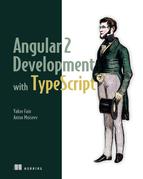Table of Contents
Chapter 1. Introducing Angular 2
1.1. A sampler of JavaScript frameworks and libraries
1.2. High-level overview of AngularJS
1.3. High-level overview of Angular
1.4. An Angular developer’s toolbox
1.5. How things are done in Angular
Chapter 2. Getting started with Angular
2.1. A first Angular application
2.2. The building blocks of an Angular application
2.3. The SystemJS universal module loader
2.3.1. An overview of module loaders
2.4. Selecting a package manager
2.5. Hands-on: getting started with the online auction
Chapter 3. Navigation with the Angular router
3.5. Developing a SPA with multiple router outlets
3.6. Splitting an app into modules
3.8. Hands-on: adding navigation to the online auction
3.8.1. Creating ProductDetailComponent
3.8.2. Creating HomeComponent and code refactoring
3.8.3. Simplifying ApplicationComponent
3.8.4. Adding a RouterLink to ProductItemComponent
Chapter 4. Dependency injection
4.1. The Dependency Injection and Inversion of Control patterns
4.1.1. The Dependency Injection pattern
4.3. A sample application with Angular DI
4.4. Switching injectables made easy
4.5. The hierarchy of injectors
4.6. Hands-on: using DI in the online auction application
4.6.1. Changing the code to pass the product ID as a parameter
Chapter 5. Bindings, observables, and pipes
5.2. Reactive programming and observables
5.2.1. What are observables and observers?
Chapter 6. Implementing component communications
6.1. Inter-component communication
6.3. A high-level overview of change detection
6.4. Exposing a child component’s API
6.5. Hands-on: adding a rating feature to the online auction
7.5. Hands-on: adding validation to the search form
7.5.1. Modifying the root module to add Forms API support
7.5.2. Adding a list of categories to the SearchComponent
7.5.4. Refactoring the template
Chapter 8. Interacting with servers using HTTP and WebSockets
8.1. A brief overview of the Http object’s API
8.2. Creating a web server with Node and TypeScript
8.2.1. Creating a simple web server
8.3. Bringing Angular and Node together
8.3.1. Static resources on the server
8.3.2. Making GET requests with the Http object
8.4. Client-server communication via WebSockets
8.5. Hands-on: implementing product search and bid notifications
Chapter 9. Unit-testing Angular applications
9.2. What comes with Angular’s testing library
9.3. Testing a sample weather application
9.3.2. Testing the weather router
9.5. Hands-on: unit-testing the online auction
Chapter 10. Bundling and deploying applications with Webpack
10.2. Creating a basic Webpack configuration for Angular
10.3. Creating development and production configurations
10.3.1. Development configuration
10.5. Hands-on: deploying the online auction with Webpack
10.5.1. Starting the Node server
Appendix A. An overview of ECMAScript 6
A.1. How to run the code samples
A.3. Optional parameters and default values
A.5. Arrow function expressions, this, and that
A.6. Iterating with forEach(), for-in, and for-of
A.8. Asynchronous processing with promises
A.9.2. Loading modules dynamically with the ES6 module loader
Appendix B. TypeScript as a language for Angular applications
B.1. Why write Angular apps in TypeScript?
B.3. Getting started with TypeScript
B.4. TypeScript as a superset of JavaScript
B.8.1. Declaring custom types with interfaces
B.9. Adding class metadata with annotations
B.11. An overview of the TypeScript/Angular development process
